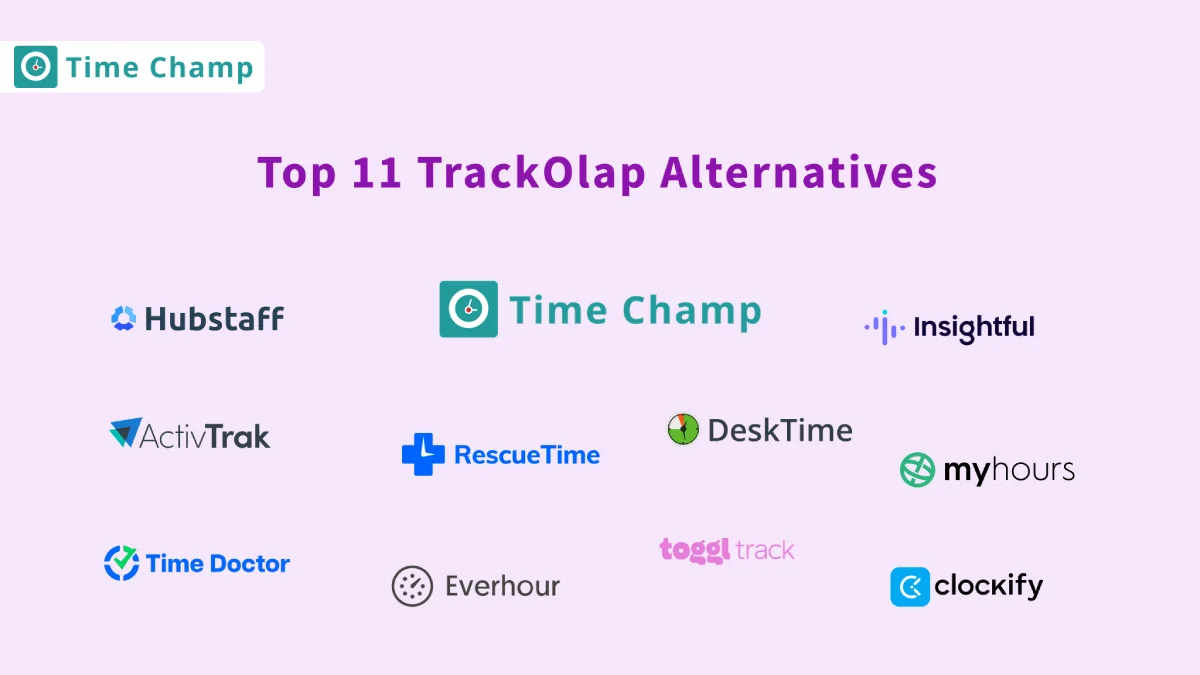The key to managing remote teams is not only about the clock-in and clock-out, but it's also about monitoring productivity, ensuring transparency, and allowing accountability without micromanagement.
Although TrackOlap has time tracking and employee monitoring capabilities, it might not be the perfect solution for the needs of every remote team, particularly when flexibility, integrations, and user experience are taken into account.
No matter whether you supervise a fully remote team, manage freelancers across time zones, or hybrid teams, a proper tool can be the difference-maker. This blog will unveil 11 effective TrackOlap alternatives that are tailored to help you simplify the management of remote teams, increase productivity, and remain in control regardless of where your team is.
Why Look for Alternatives to TrackOlap?
TrackOlap is a popular employee monitoring and time tracking tool, and its limitations are becoming clear as more teams go remote. There can be a lack of flexibility in terms of customizing the workflows, creating comprehensive productivity reports, or connecting to the most popular project management tools to use among distributed teams. As a remote team manager, having a user-friendly tool, the ability to communicate openly, and the possibility to scale are vital, and TrackOlap does not perform perfectly in these areas.
In addition, the focus of TrackOlap on monitoring can be somewhat intrusive and, therefore, does not resonate with the culture of trust and autonomy that remote teams depend on. The current remote working conditions require the tools that would balance the visibility and flexibility. They can provide the insights but not micromanaging. Teams are also demanding more options to offer them a better user experience, promote productivity, and fit into their existing remote workflows.
Key Features of TrackOlap
- Time and attendance tracking
- App and website usage monitoring
- Productivity reports and analytics
- Task and project tracking
- Leave and shift management
- Mobile access for remote monitoring
Limitations of the TrackOlap
-
Surveillance-Heavy Monitoring
Features like continuous screenshots, real-time monitoring, and activity capture can feel invasive, especially in remote working situations where trust and autonomy are critical. This can create employee dissatisfaction.
-
Complicated User Interface
Many users feel that the platform is cluttered and complicated. This can slow down onboarding for new employees or managers and cause friction in day-to-day use.
-
Limited Integrations with Work Tools
TrackOlap doesn't integrate with popular remote work tools such as Slack, Trello, ClickUp, or Google Workspace. This can slow down the automation process of work and force teams to juggle multiple tools manually.
-
Minimal Customization Options
The platform does not support much flexibility in creating dashboards, user roles, or even report settings. It is a barrier to teams that have different workflows or requirements in compliance.
-
Not Built for Async or Global Teams
TrackOlap works better in regular 9-to-5 setups that are synchronized. It is also lacking in features that aid asynchronous collaboration, time zone awareness and flexible time plan, making it less ideal for distributed or global teams.
Quick Comparison of TrackOlap Alternatives
While TrackOlap offers solid tracking features, it may not meet the unique demands of every team. Here’s a quick comparison of top alternatives that provide better flexibility, usability, and performance for varied business needs.
| Solution | Key Features | Pricing | Ratings |
|---|---|---|---|
| Time Champ |
|
|
|
| Hubstaff |
|
|
|
| Time Doctor |
|
|
|
| DeskTime |
|
|
|
| ActivTrak |
|
|
|
| Clockify |
|
|
|
| Toggl Track |
|
|
|
| RescueTime |
|
|
|
| Everhour |
|
|
|
| My Hours |
|
|
|
Best TrackOlap Alternatives for Managing Remote Teams Effectively
If you're looking for a more intuitive or feature-rich solution than TrackOlap, these alternatives offer better tools for time tracking, productivity insights, and remote team management that align to the modern workflows.
1. Time Champ
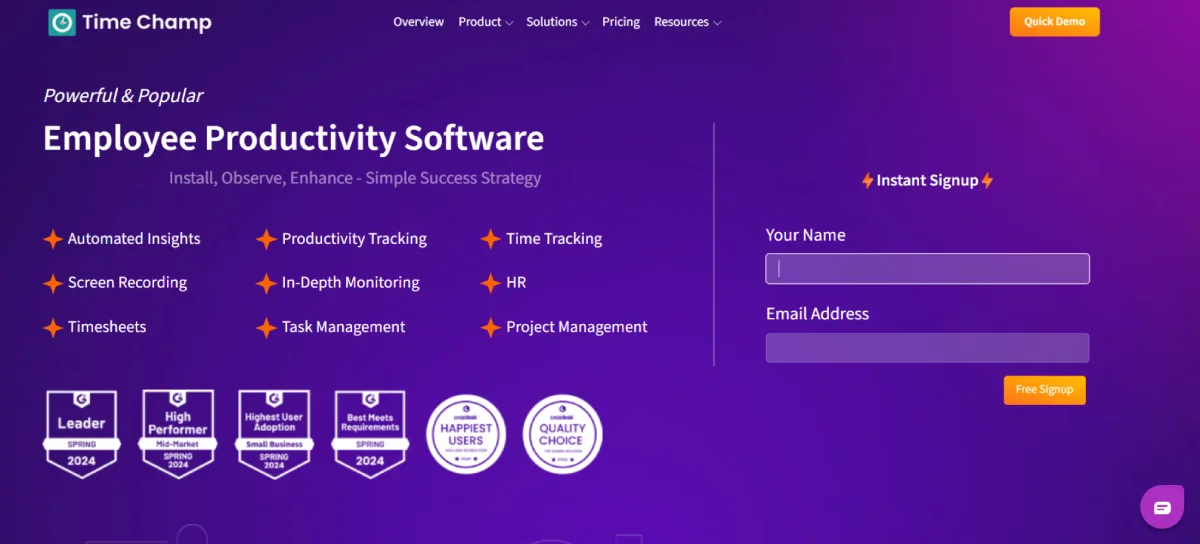
Time Champ is an all-in-one time tracking and productivity monitoring platform designed specifically for modern remote and hybrid teams. Focusing on transparency, accountability, and team efficiency, Time Champ helps organizations monitor work patterns, optimize workflows, and ensure high productivity without micromanagement.
The platform is ideal for startups, SMEs, and enterprises looking to move beyond traditional tracking tools by offering intelligent automation, real-time insights, and powerful integrations. Whether it’s tracking work hours, managing employee attendance, analyzing productivity trends, or producing audit-ready reports, Time Champ simplifies the process of team management, encouraging a culture of trust and productivity.
Key Features
-
Automatic Attendance & Time Tracking
Automatically records employee logins, clock‑ins/outs, breaks, multi‑shift schedules, and idle time, eliminating manual entries and streamlining payroll and attendance management.
-
Project & Task Management
Assign and monitor tasks, manage sprints and project timelines, allocate resources, and visualize progress through calendars and dashboards.
-
Employee Monitoring and Activity Tracking
Capture app and website usage, keystrokes, mouse movements, live screens, screenshots, audio logs, and screen recordings for comprehensive visibility and accountability.
-
Insight Dashboards & Productivity Reports
Visualize team and individual performance trends with heatmaps, usage breakdowns, productivity labelling (productive, unproductive, idle), and scheduled or ad‑hoc reports.
-
Location Tracking & Geofencing
Monitor employee locations with GPS, track site visits and route timelines, and configure geofences for attendance or project compliance.
-
Automated Alerts & Notifications
Receive real‑time alerts through email or in-app when employees are late, idle, or engaged in suspicious activity, helping managers stay proactive.
-
HR Management & Leave Tracking
Manage employee profiles, organizational hierarchies, leave balances, approvals, and shift scheduling via integrated HR modules.
-
Extensive Integrations & API Access
Seamlessly integrate with tools like Slack, Trello, Asana, Jira, Azure AD, and more and full API access for custom workflows and data export.
-
Privacy Controls & Monitoring Modes
Choose between silent background monitoring or interactive personal-device clock-in modes; also use blurred screenshots, selective data deletion, and secure access controls.
Pros
- Real-time tracking of apps, websites, and screen activity
- Automated attendance and productivity monitoring>
- Built-in task and project management
- Remote-team friendly with stealth and privacy options
- Custom alerts and role-based access
Cons
- May require brief onboarding to explore the full feature set
- Advanced settings might need initial configuration
Pricing
- 7-day free trial.
- Starter: $3.9/user/month
- Professional: $6.9/user/month
- Enterprise: $13.9/user/month
Ratings
2. Hubstaff
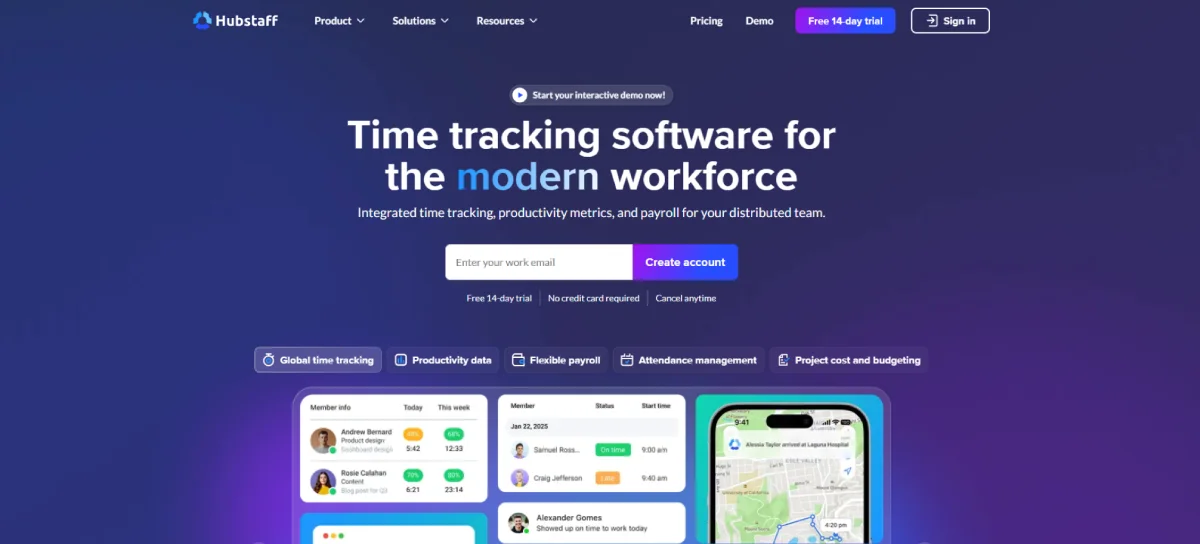
Hubstaff is a time-tracking and productivity monitoring system that is designed to work with distributed, hybrid, and field workforce. It allows managers to monitor the activity of the employees in real-time, create payroll-ready timesheets, and organize projects without compromising employee privacy upon their request through features such as blurred screenshots and no keystroke logging.
Key Features
- Time tracking with activity monitoring (screenshots, idle time)
- GPS tracking & geofencing for mobile/field teams
- Detailed productivity reports & timesheets
- Built-in payroll, invoicing, and team scheduling
- Project management tools with 30+ integrations
Pros
- Scales well for growing remote teams
- Builds trust with transparent reporting
- Useful for freelancers and client billing
- Offers flexible user roles and access control
Cons
- The interface can look cluttered for new users
- Steeper learning curve for advanced settings
- Occasional sync or lag issues with the desktop app
- Expensive for small teams compared to alternatives
Ratings
3. Time Doctor
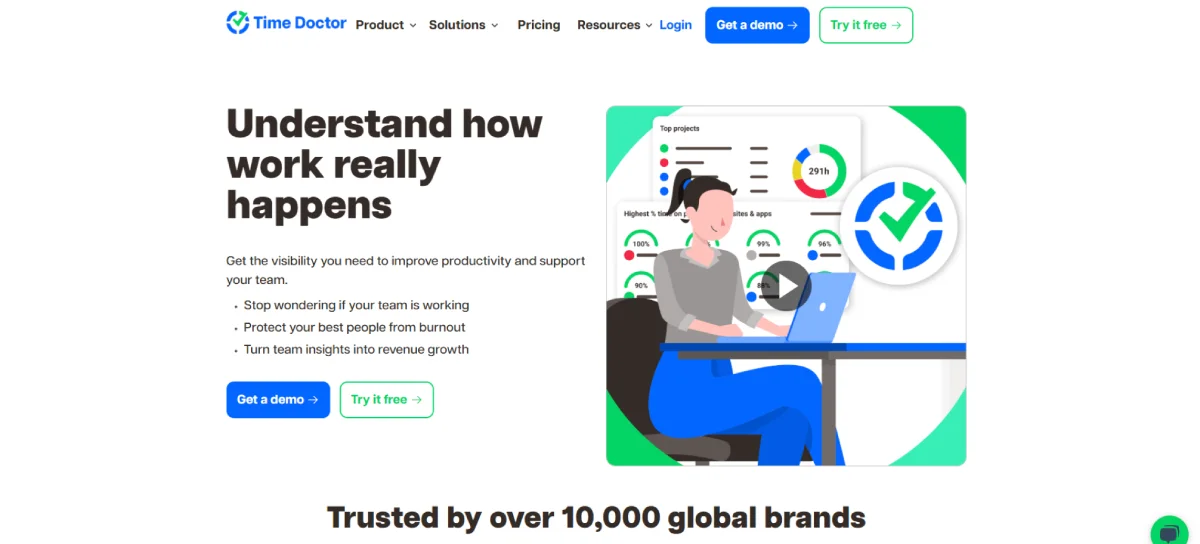
Time Doctor is a remote team management tool that can facilitate time tracking, productivity monitoring, GPS tracking and team scheduling. Distributed teams, agencies, and field service businesses use it widely to extend accountability and make operations much easier.
Key Features
- Automatic time tracking and timesheets
- Screenshot and activity level monitoring
- GPS location and geofencing for field teams
- Invoicing, payroll, and client reporting
- Project budgeting and task tracking
Pros
- Scales well for distributed and growing teams
- Builds accountability with transparent tracking
- Ideal for freelancers and client-based work
- Offers customizable roles and permissions
Cons
- Interface feels overwhelming to new users
- Learning curve for advanced functionalities
- Occasional sync issues in desktop app
- Pricing may be high for small businesses
Pricing
- 14-day free trial
- Basic: $6.70/user/month
- Standard: $11.70/user/month
- Premium: $16.70/user/month
- Enterprise: Custom pricing
Ratings
4. DeskTime
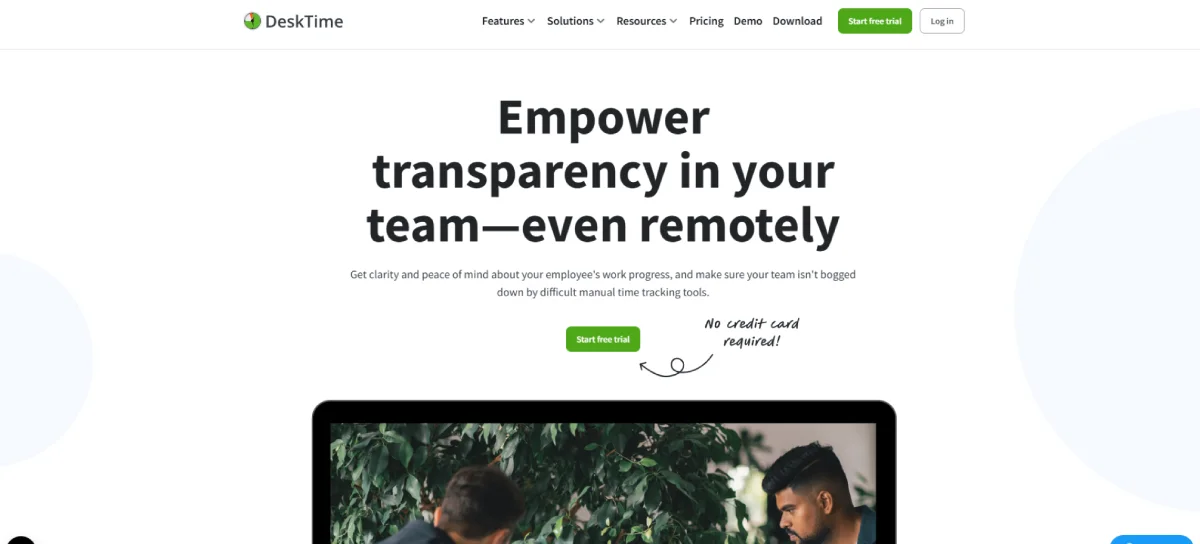
DeskTime is an automatic time tracker and productivity tool developed for remote, hybrid, and in-office teams. It monitors working time, time spent on apps and websites, and non-work periods without any manual intervention. The tool also comprises project monitoring, shift management and integration with common apps. DeskTime assists companies to increase efficiency and hold teams accountable.
Key Features
- Real-time automatic time tracking
- App, website, and idle time monitoring
- Project and task tracking
- Shift scheduling and private time mode
- Integrations with tools like Trello, Jira, and Google Calendar
Pros
- Easy to set up and use with minimal learning curve
- Boosts productivity with real-time insights
- Supports both remote and hybrid team structures
- Affordable plans for small to mid-sized teams
Cons
- Limited customization for reports
- Mobile app has fewer features than desktop version
- May feel intrusive to some team members
- Lacks advanced project management tools
Pricing
- Lite: $0/1 user
- Pro: $4.58/user/month
- Premium: $6.42/user/month
- Enterprise: Custom plans
Ratings
5. Activtrak
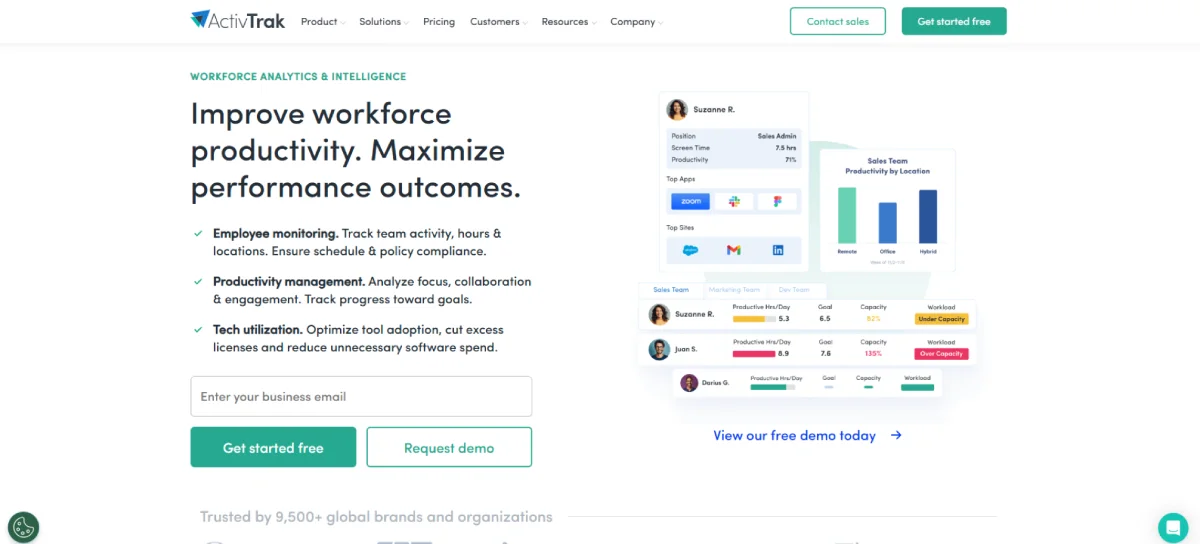
ActivTrak is a cloud-hosted workforce analytics and productivity tracking software, which targets remote, hybrid and distributed workforces. It focuses on non-intrusive tracking, no keystroke, and no screen recording to assist managers in knowing working patterns, optimizing workload, and making it more transparent without affecting the privacy of employees.
Key Features
- Real-time tracking of apps, websites, and user activity
- Productivity categorization and behavioural analytics
- Focus time and distraction alerts
- Optional screenshot capture and alarms
- AI-powered productivity coaching and insights
Pros
- No keystroke logging, ensuring better employee privacy
- Clean dashboard with actionable productivity insights
- Helps identify burnout risks and workload imbalance
- Free plan available for small teams
Cons
- Setup can be time-consuming for first-time users
- Some users report data delays or sync issues
- Limited offline tracking compared to some tools
- The screenshot feature may raise privacy concerns in certain teams
Pricing
- Free plan with only time tracking feature
- Essentials: $10/user/month
- Essential Plus: $15/user/month
- Professional: $19/user/month
- Enterprise: Custom Pricing
Ratings
6. Clockify
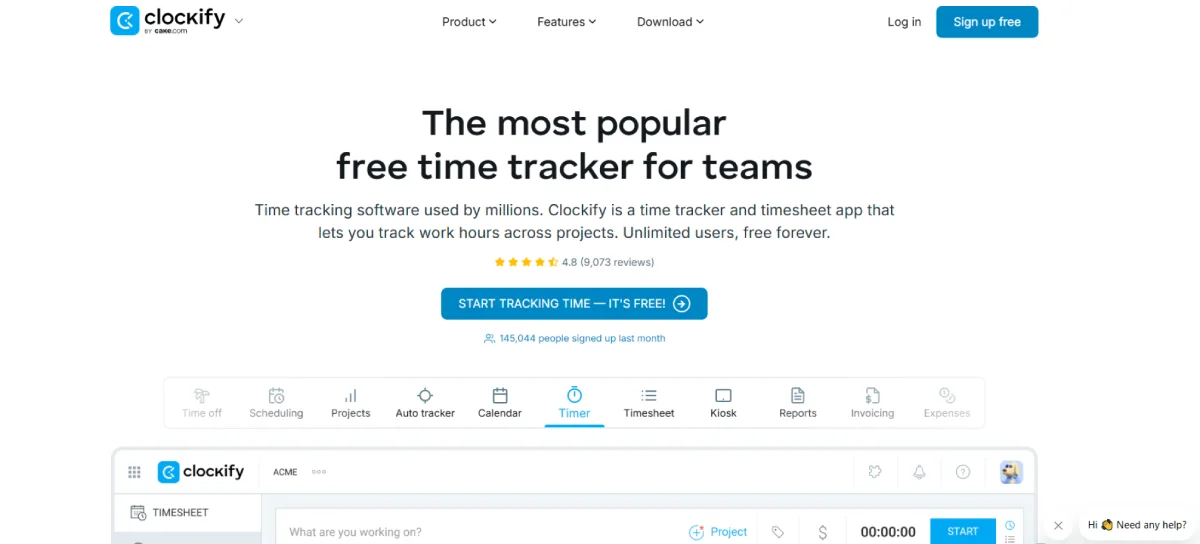
Clockify is an open-source, cloud-based time-tracking and productivity tool to be used by individuals and teams. It has real-time timers, automatic tracking of activities, project-based timesheets, and detailed reporting. Clockify has cross-platform functionality, and integrations with some of the most popular apps, enabling remote and hybrid teams to keep track of working hours. It also simplifies the process of attendance and enhances accountability.
Key Features
- Time tracking for projects, tasks, and billable hours
- Timesheet and calendar views for easy logging
- Detailed reporting with export options
- Team activity and attendance monitoring
- Integration with over 80 tools including Trello, Asana, and Slack
Pros
- Easy to set up and use
- User-friendly interface
- Works across platforms with offline mode
- Strong reporting for productivity insights
Cons
- The mobile app can sync slowly
- Limited customization in reports
- Lacks advanced automation
- Reporting and invoicing tools are basic
Pricing
- Free for unlimited users with limited time tracking features
- Basic: $3.99/user/month
- Standard: $5.49/user/month
- Pro: $7.99/user/month
- Enterprise: $11.99/user/month
Ratings
7. Toggl Track
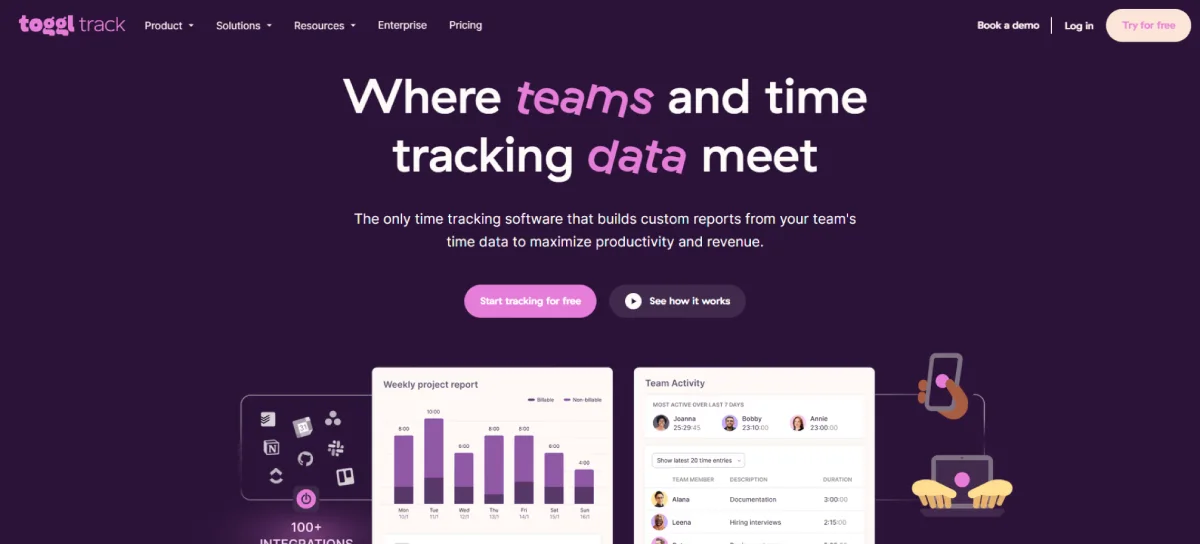
Toggl Track is a simple and user-friendly time tracking tool designed for freelancers, teams, and businesses. It helps users log hours, analyze productivity, and generate reports effortlessly. With its intuitive interface and powerful integrations, Toggl Track is ideal for those who need to track time across multiple projects without micromanagement or complexity.
Key Features
- One-click timer, Pomodoro mode, and manual time entries
- Automatic idle detection and calendar integration
- Customizable reports with billable hours and timesheets
- Integrates with tools like Asana, Slack, and Google Calendar
- Works on web, mobile, desktop with offline sync
Pros
- Simple UI and quick onboarding
- Free plan supports up to 5 users
- Strong reporting and forecasting tools
- Offline tracking with later sync
Cons
- Lacks productivity monitoring features
- Occasional sync issues across devices
- Manual approval for timesheets
- Premium plans are costly for large teams
Pricing
- Free - $0/user/month: Ideal for up to 5 users
- Starter - $9/user/month
- Premium - $18/user/month
- Enterprise - Custom pricing
Ratings
8. Insightful
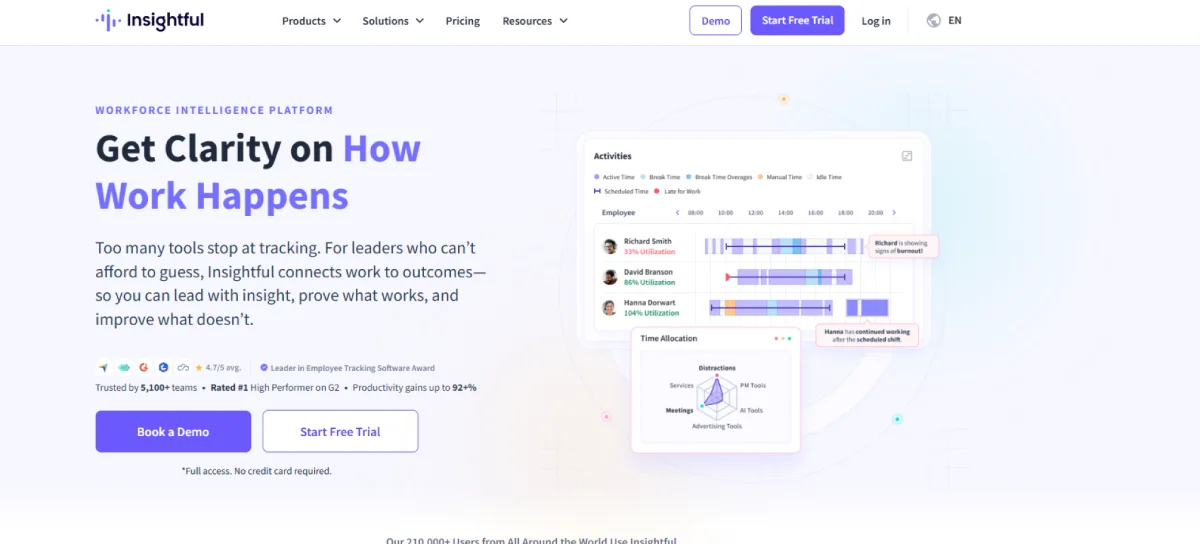
Insightful is a workforce analytics and productivity platform. It is designed for hybrid and remote teams. Insightful combines real-time monitoring of app and website activity, automated time mapping, and AI-powered insight, including burnout detection and insider threat alerts to turn raw activity into actionable operational intelligence.
Key Features
- Real-time app, website & project tracking with idle detection
- Productivity insights with behaviour analytics
- Optional screenshots & URL blocking
- Role-based dashboards & automated alerts
- Supports on-premises/cloud deployment & 50+ integrations
Pros
- Strong focus on employee privacy
- Deep behavioural analytics & AI-driven insights
- Flexible deployment options
- Activity-based payroll & scalable for teams
Cons
- Setup can be overwhelming initially
- Minor delays in sync & idle detection
- Limited project management features
- Advanced tools locked behind higher-tier plans
Pricing
- 7-day free trial.
- Productivity Management: $6.40/user/month
- Time Tracking: $8/user/month
- Process Improvement: $12/user/month
- Enterprise: Custom pricing
Ratings
9. Rescue Time
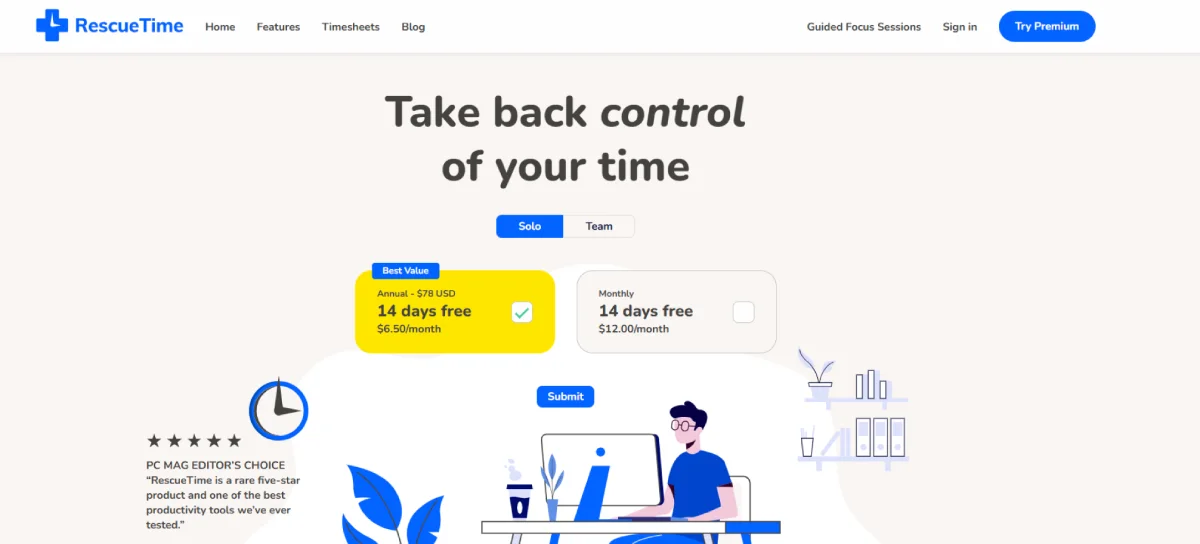
RescueTime is an automated productivity and time management platform used by individuals and remote-focused teams. Operating in the background, it tracks app and website usage, generates detailed reports, and helps users set and meet productivity goals through features like Focus Sessions. RescueTime emphasises well-being by offering personal and team analytics while preserving user privacy.
Key Features
- Automatic time tracking across apps, websites, and tasks
- Daily focus work goal and productivity scoring
- Distraction blocking (Focus Session mode)
- Real-time alerts and detailed reports
- Weekly summary emails and trend insights
Pros
- Simple and minimal UI, perfect for individuals
- Excellent focus enhancing tools
- Passive time tracking with no manual input
- Insightful productivity trends over time
Cons
- Limited team collaboration tools
- No screenshot or keystroke monitoring
- Lacks advanced task or project management
- Unable to track offline activities
Pricing
-
Individual Plans:
- Lite: Free
- Premium: $12/user/month
- Team Plan: $9/user/month
Ratings
10. Everhour
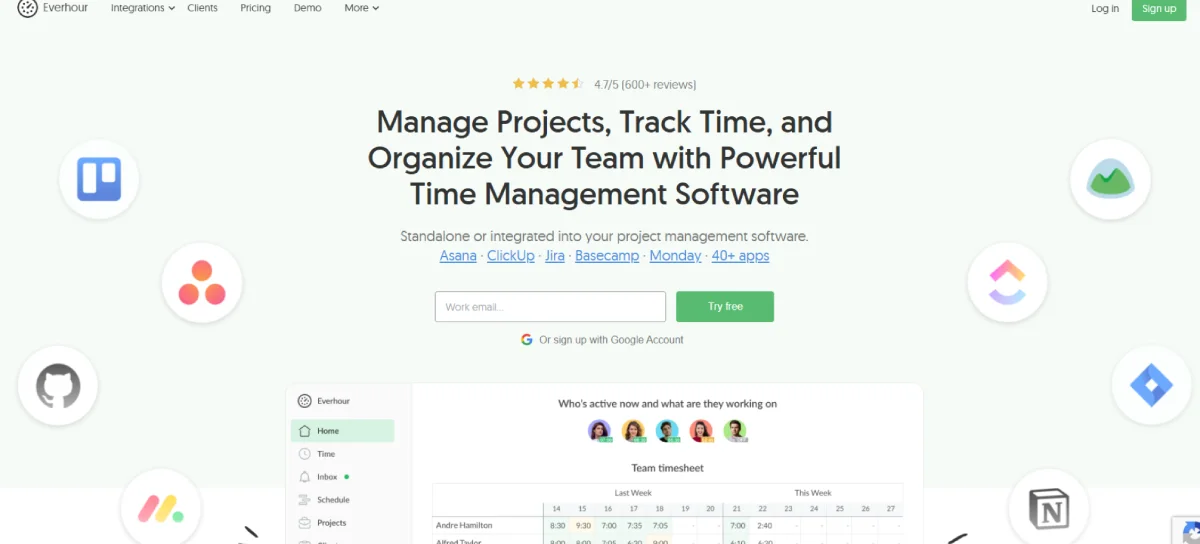
Everhour is a cloud-based time tracking tool designed for project-based teams. It integrates seamlessly with platforms like Asana, Trello, ClickUp, and Jira, making it easy to log hours directly within task workflows. It’s especially useful for budgeting, client invoicing, and keeping track of billable vs non-billable hours.
Key Features
- Real-time task and project-based time tracking
- Seamless integrations with tools like Asana, Trello, GitHub
- Custom reports and visual dashboards
- Budgeting, invoicing, and billable hour tracking
- Team scheduling and workload management
Pros
- Excellent integration with project management tools
- Powerful and customizable reporting system
- Intuitive UI with easy onboarding
- Responsive and helpful customer support
Cons
- No offline tracking and limited mobile functionality
- Complex navigation when managing multiple projects
- Lacks advanced features like Gantt charts
- Pricing may be high for small teams
Pricing
- Free Plan: $0/month for up to 5 users; only basic time tracking
- Team Plan: $10/user/month ($8.50 billed annually)
Ratings
11. My Hours
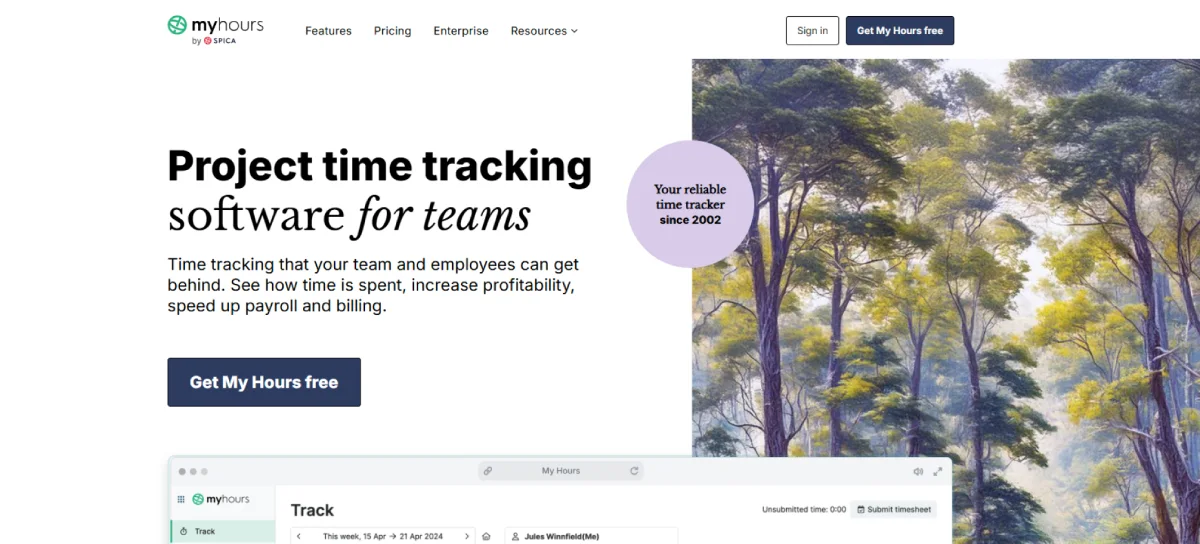
My Hours is a time-tracking platform designed for teams, integrated with tools like Asana, Trello, and GitHub. It excels in task-based tracking, budget and billable hour management, and customizable reporting. With seamless integration into existing workflows, it minimizes setup friction. Its intuitive interface and responsive support make it ideal for agencies, freelancers, and project-based teams.
Key Features
- Task and project-based time tracking
- Seamless integrations with tools like Asana, Trello, GitHub
- Custom reports and visual dashboards
- Budgeting, invoicing, and billable hour tracking
- Team scheduling and workload management
Pros
- Excellent integration with project management tools
- Powerful and customizable reporting system
- Intuitive UI with easy onboarding
- Responsive and helpful customer support
Cons
- No offline tracking and limited mobile functionality
- Complex navigation when managing multiple projects
- Lacks advanced features like Gantt charts
- Pricing may be high for small teams
Pricing
- Free: $0 up to 5 users
- Pro: $8/user/month
- Enterprise: Custom Pricing
Ratings
How to Select the Right Software for Your Team's Needs?
Selecting the ideal time tracking software starts with understanding your team’s goals. Are you aiming to improve productivity, manage remote employees, or simplify client billing?
Based on your needs, prioritize features like automatic time tracking, detailed reports, task management, integrations, or employee monitoring. For growing teams, scalability and multi-platform support are essential, while small teams may benefit more from simplicity and ease of use.
Beyond features, evaluate the software’s user interface and learning curve. A tool that's too complex might reduce adoption across your team. Also, consider customer support quality, pricing structure, and whether it aligns with your budget. Most platforms offer a free trial; take advantage of it to test the fit before fully integrating it into your workflow. Choosing the right tool not only saves time but also enhances team performance in the long run.
Conclusion:
Selecting a time tracking tool starts with understanding how your team works and what challenges you’re trying to solve. For organizations needing comprehensive monitoring and control, tools like Time Champ, Insightful, and Hubstaff offer deep visibility and robust monitoring features. These are ideal for large or remote teams requiring high accountability.
If your team prefers a more flexible and user-friendly experience, Toggl Track, Clockify, and Everhour provide streamlined interfaces and easy integrations. On the other hand, if individual productivity and focus are top priorities, RescueTime and ActivTrak offer non-invasive tracking and insightful reports. By matching your priorities to the strengths of each platform, you can boost efficiency without adding friction.
Frequently Asked Questions
For remote teams, tools like Time Champ, Hubstaff, and Insightful offer real-time monitoring, productivity analytics, and automated timesheets that make remote work efficient and transparent.
These tools provide detailed insights into how time is spent, helping teams identify distractions, optimize workflows, and ensure accountability, ultimately boosting overall productivity.
Yes, many tools like Time Champ, Everhour, Desktime, and Toggl Track offer offline tracking modes, ensuring time is logged even without an internet connection.
For deeper employee monitoring, tools like Time Champ, ActivTrak, and Insightful provide screen monitoring, app usage tracking, and productivity scoring.
Here are Some Related Articles You may Find Interesting

What is the Average Salary in Bangladesh: Overview & Insights
Discover The Average Salary in Bangladesh and outsourcing impact. Learn why it’s a rising player in global outsourcing.

Average Salary in India: Factors and Comprehensive Comparison
Discover the key factors influencing the average salary in India across industries, regions, and job levels, as well as insights.

What is the Average Salary in Colombia? & Factors Affecting
Discover the average salary in Colombia and explore the key factors affecting earnings, including industries, experience, and location. Find out.

What is the Average Salary in Indonesia?
Discover the average salary in South Africa and explore outsourcing trends. Learn key insights into wages, industries, and business opportunities.

What is the Average Salary in Hong Kong? and It’s Statistics
Learn about the average salary in Hong Kong, from minimum wage to maximum salaries, and gain insights into industry variations.

What is the Average Salary in Singapore: Economic Outlook
Discover the average salary in Singapore, key factors affecting income, insights into the nation’s economic outlook & explore its trends.
